Back in 2019, we decided that it time to move house. Specifically, it was time to get that house in the country, that we’d always talked about. 2019 was a quiet time in my cancer treatment and, given I was having cancer treatment, if we didn’t move then, it might be too late. The house we fell in love with came with a lot more land than we needed. In fact, there was an entire two acre (one hectare) field we didn’t know what to do with. Eventually a thought arose: why don’t we just plant a forest…?!
After we’d moved in to our new home, it quickly became clear that the field had been effectively unused by the previous household. The previous owner had an arrangement with a local farmer, such that the field would be left to go to grass, which, in autumn, the farmer would collect for hay. In return, the farmer would overcharge the household for the annual cutting of the property’s hedges.
It was not a good deal!
Additionally, at some point in the past, part of the field had been used for livestock. In fact, remains of what was probably a pigpen stood in the far corner of the field. Given this, we’d briefly contemplated the idea of getting livestock of our own. Something along the lines of a few sheep or goats to keep the grass down. Or, if the girls had their way, a herd of alpacas.
But we very quickly realised that this would have been a terrible idea. We’re not farmers, so we don’t know how to look after livestock. As such, there was a very real chance that we’d put the animals in harm’s way, which was simply unacceptable. I mean, sure, we could have learned the correct animal husbandry, but neither of us had the time or the desire.
Long story, short: no animals.
Besides, there was plenty of wildlife up there already. Particularly rabbits, foxes and deer.
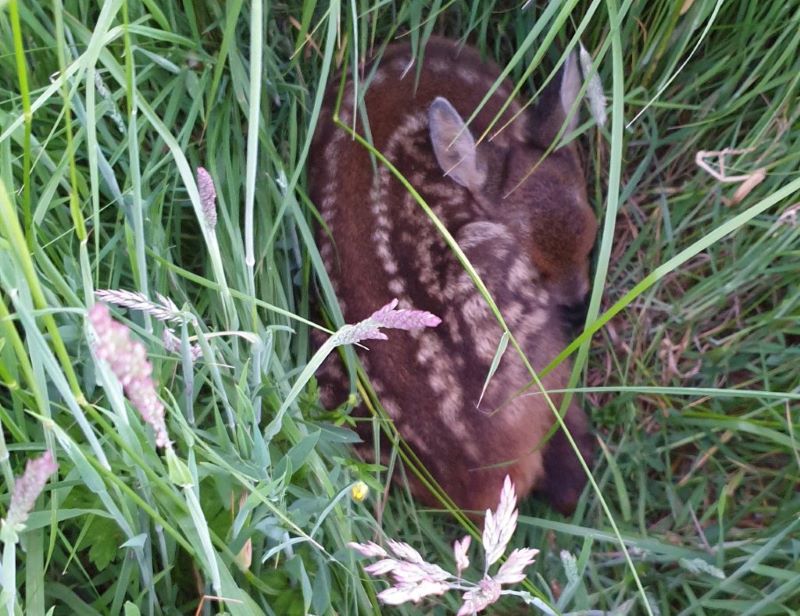
The only existing thought about what to do with the field, was that I wanted to plant some fruit trees somewhere on the grounds. And the field was definitely ‘somewhere’. The reason for the fruit trees, is that I’ve always liked the idea of having some sort of orchard. I even have vague plans about preserving the various fruits in an assortment of exciting ways…
So, in an ideal world, I wanted to have enough space for one of every type of fruit tree I could get my hands on. (And two of each of the types that aren’t self-pollinating). At which point Julie pointed out that there was no reason we couldn’t fill the whole space with trees… We could use the field to plant our own forest.
Well, there was an idea…!
And what a great idea it was. Not only did it allow the existing wildlife to keep using the field, it would add more environments for other animals to move in. Furthermore, we would be able to offset the whole family’s carbon footprint.
Happy days!
[I thought I’d better double-check this carbon footprint claim. Until now, I’ve just been assuming that if we plant a forest up there, it’ll offset our carbon footprint. You know, because it sounds logical… But we all know how easy it is to go wrong with assumptions! Thankfully, according to Saving Nature‘s Carbon Footprint Calculator, we’re all good. Phew!]But planting trees isn’t cheap. Whenever we’ve moved house in the past, one of the first things I do is plant a couple of fruit trees. And if you want a decent sized tree, from a reputable source, you’re looking at more than £20 ($28, €23) a tree. And a two acre field is going to take a lot of trees!
So I had a look to see if there was any funding assistance out there. And there was… the Woodland Trust. Under their MOREwoods Project, the Woodland Trust was able to cover most of the cost it would take to plant a forest. That is, providing the field was eligible under the scheme. And to make that assessment, the Woodland Trust would need to send someone to visit the site.
That someone arrived on the 25th February 2020 and seemed genuinely excited as he walked around the field. It’s always great when you meet someone who loves their job. He noted that the field was quite wet, and said that the trees would have to be chosen to reflect this. Also the presence of deer meant that the trees would need the appropriate tubing and support. This wasn’t an issue, it would just involve a bit more work when it came time to plant our forest.
After he’d looked around, we discussed the layout of the forest and the options for the trees we could plant. It very quickly became clear that the Woodland Trust would only offer a limited variety of trees under the scheme. Thankfully, these trees were pretty close to what I had in mind. For example, I ideally wanted native, deciduous trees, and this turned out to be all that the Woodland Trust was offering. I also wanted a bunch of fruit trees for the orchard idea, but these weren’t on the cards.
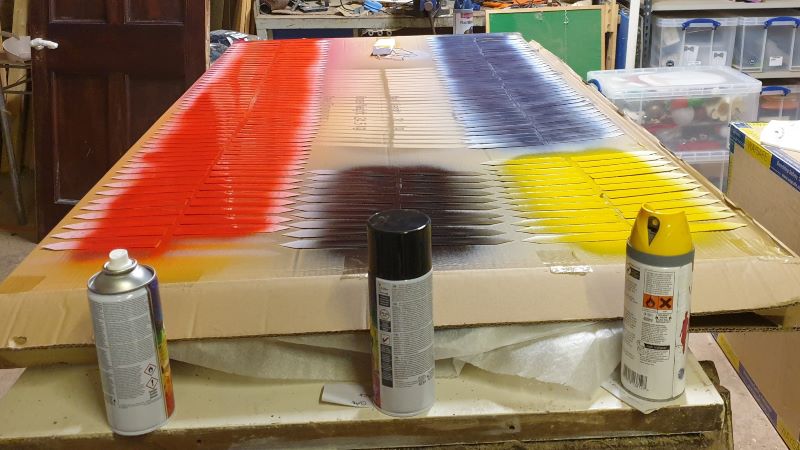
He did, however, include 25 Walnut trees in his recommendation. This was really nice of him because, as it turns out, Walnut isn’t a native tree. He also included 50 Wild Cherry trees, along with the suggestion that we replace some of them with edible cherry trees. He felt sure that we would be able to find homes for the wild cherry trees.
And, although this was a wonderful idea, the coronavirus lockdown made it impossible to find a supplier, when the time came. But that’s hardly the end of the World. Besides, I can always plant some edible cherry trees at a later date.
As you might expect from all this, his recommendation was accepted by the Woodland Trust. The trees, however, would not arrive until 15th December 2020.
The main reason for the delay in this date, is the fact that trees have to be planted during winter, when they’re dormant. And the reason that I chose the 15th, specifically, was that Emma wanted to be involved in the planting, and she’d be home from university by then. The 15th would also give me a decent chunk of time after the farmer collected his hay.
For the final time.
Actually, I’m not sure that the farmer is aware that it was the last time. Mind you, maybe he is, because he’s certainly made no effort to contact us for a time to cut our hedges…
Anyway, my point is that I needed some time to prepare the field, before we could plant our forest…
For a start, there is a hedge that runs the length of the field, about three quarters of the way across. This, naturally, would be left to become overgrown once the forest was in. But, by doing so, it would completely split the field into two parts. So I decided to open some gaps in the hedge, thus preventing this from becoming an issue. There was also a massive bramble patch in one corner of the field. And I wanted this gone, at least long enough to plant some trees in that space.
After all, once brambles are that dug in, there’s no way to get them out short of using weed-killer. Which is something I want to avoid. So I hired a digger, and gouged the brambles down to their roots. This won’t stop them, of course, but I only need to control them for a couple of years. After which time, the trees will be established enough, and tall enough, that I can let nature take its course.
I also used the digger to clear the gaps in the hedge. I’d never used a digger before and can highly recommend it; as it’s really good fun. Well, until you throw a track, because you don’t know what you’re doing. But, once the track’s back in place, the fun can go on…
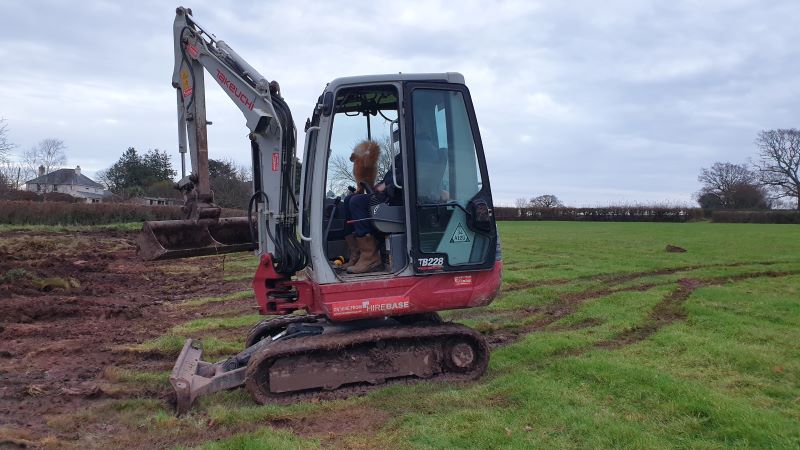
And when the field was finally the way I wanted it, all I had to do was get the grass short enough to make the planting easier. Unfortunately, I didn’t have a big enough mower to make this a quick and easy job. So: slow and difficult, it was.
I spent days on that damn mower!
In and around all the mowing, I had to work out where we were going to plant the trees and shrubs. Because we were going to be getting a lot of them!
- 950 Trees:
- 200 Birch (Downy)
- 50 Crab Apple
- 50 Cherry (Wild)
- 75 Maple (Field)
- 500 Oak (Common)
- 50 Rowan
- 25 Walnut
- 300 Shrubs:
- 50 Dog Rose
- 50 Dogwood
- 25 Elder
- 50 Hawthorn
- 100 Hazel
- 25 Spindle
And while I did have two acres to work with, I also had some rules to follow. The Oak trees had to be planted in circular clusters of 25. The clusters were based around a central Oak, with a ring of eight more, a meter out, then a ring of another 16, a further meter out. These Oak clusters were to be planted at 16 meter centres. All the other trees were to be planted, in rough lines, in and around the Oak clusters, three meters apart from each other.
To further complicate matters, we were going to have a path that wound through the forest. So it made sense to have the more attractive trees lining this path. But the edges of the path, itself, would be marked by shrub borders. And these shrubs needed to be a good meter from the trees. And all of this planting still needed to leave a path wide enough to walk through, without getting slapped in the face by branches every couple of paces. In reality, though, the path needs to be wide enough to get our little tractor up, in case we need to do so…
What I’m getting at, is that there was a lot to take into account.
So I printed out an image of the field from Google Earth, and then paced out the dimensions, just to be sure. I then recreated the shape and dimensions in Excel, of all things. The main reason I chose Excel was because I already had it, and knew how to use it. Secondly and, I hoped, usefully, I could scale the grid lines to represent meter squares. I could then fill the grid, using a variety of colours for the different tree types, and use the spacing rules to get an even spread.
It almost worked, too.
Almost!
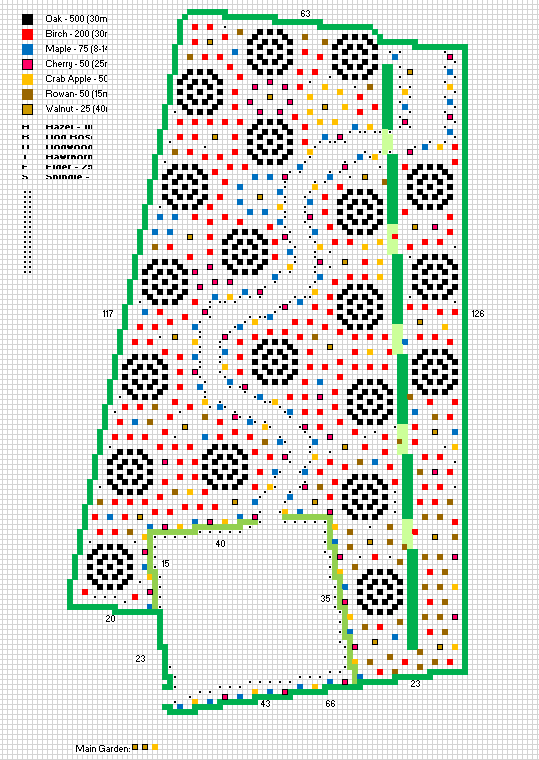
Even so, the gaps between the trees got a little… interesting… towards the top of the field.
By now, it was start of December. The grass was as short as it was ever going to be, and was unlikely to grow much in the next couple of weeks. The tags had been put out, meaning when it came time to plant our forest, there would be no time wasted working out the spacings. And this was important, because we’d only have seven days to plant everything. After seven days, the trees would begin to die off, and would need ‘heeling in’ to avoid this.
Basically, if we couldn’t plant our forest within the week, we’d end up having to plant some of the trees twice. And there simply wouldn’t be time to plant the trees twice, and leave time to prepare for Christmas. And I know that this Christmas was to be a much simpler, pre-ordered version, but even so… No one wanted to be planting trees on Christmas Eve!
Fortunately, the trees were long since paid for, so we didn’t have to worry about that aspect of things impacting on Christmas. Even more fortunately, G&L Consultancy Ltd had very kindly opted to sponsor the forest, in line with their environmental policy. As such, the financial impact on us was limited to the preparation costs, like the digger, and ancillary costs, like buying more posts and tubes.
Many thanks to both the Woodland Trust and G&L Consultancy Ltd for allowing us to plant our forest.
And then, a week before the trees were due to arrive, the rain came.
And the field went from being firm underfoot to a quagmire. This had a knock-on effect on us, because it meant we had to change the way we would plant the forest. We’d initially been planning to use the ‘T-notch planting‘ technique. But now the ground was so wet, we would have to use ‘slit planting’. The good news was that slit planting was much quicker and easier… Result!
We were ready!
And, on 15th December 2020, the anticipation was finally over when the trees arrived as scheduled.
Well, I say ‘trees’…!
What we actually got were very small saplings called, bare root whips. Which is to say they were between 30cm and 90 cm tall (1-3 feet), often with little in the way of branches, and not much more in the way of roots…

Somewhat worryingly, there was very little visual difference between the ‘tree’ whips and the ‘shrub’ whips. Thankfully, everything was pretty well labelled, but if a label came off, doom was sure to follow!
As it turned out, though, there were so few of us involved in the planting, that keeping track of all the plants was quite easy. The original plan had involved planting parties of volunteers from G&L Consultancy Ltd; who take their environmental responsibilities very seriously. As it was, the pandemic rules restricted gatherings to six people.
Which meant that we’d just have to do it all ourselves…!
Well, with a little help from the family.
Okay, with a lot of help from the family!
My dad was there all day, every day, alongside Julie, Emma and me. Ceri, who was up to her ears with college work, was involved as often as she could be, and even managed to rope in a couple of friends, on occasion. My brother and sister-in-law, Simon and Ruth, came up for two of the days. On one of these days, Simon and Ruth brought their children, Emily and Benjamin, along. The kids said they wanted to help, and a great help they were too. Thanks Emily and Benjamin.
And many thanks to all concerned.
There is simply no way that we could have done it on our own.
Because, while the chap from the Woodland Trust reliably informed me that an experienced planter can plant 200 trees in a day, it turned out that none of us were experienced planters. Well, except for my dad, who was a forester back in his teens… But, what we could do, was get 300 trees in a day, between us…
And that would work nicely!
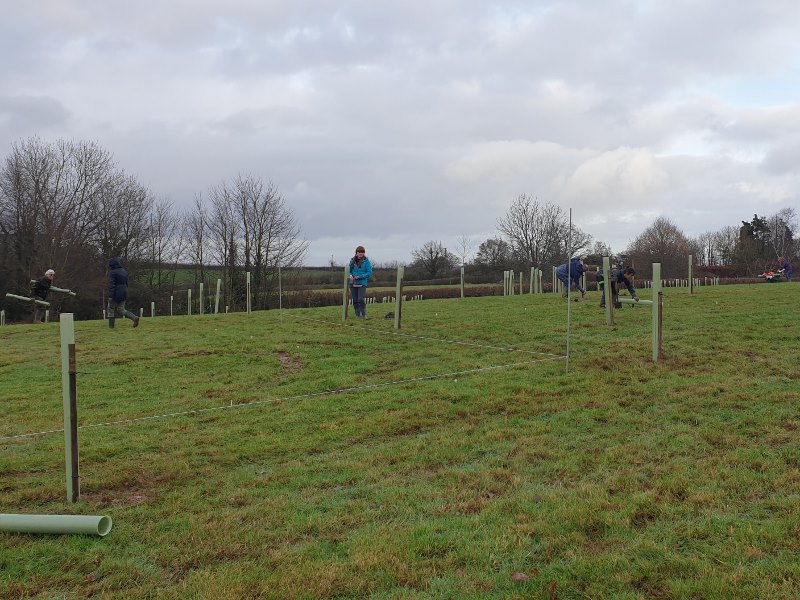
We started planting on the Wednesday. Not unexpectedly, this was the same day that the wintery weather arrived in force. Over the next four days, two storms rolled through. The other days contented themselves with simple rain. And, on one glorious afternoon, just a bit of light drizzle.
It was muddy work, but, at least, it made the ground nice and soft for the planting.
Which meant that, by Saturday, we’d done all that we could. This isn’t to say that all of the trees were in, because it doesn’t stop here…
The Woodland Trust had sent a couple of extra bundles of trees. I’m not sure why. Maybe by accident or, perhaps, as replacements for damaged trees. Whatever the reason, we were unable to plant them immediately, because we didn’t have enough stakes and protective tubes. And, getting these things, over the Christmas period, in lockdown, proved impossible.
But, towards the end of January, the stakes and tubes finally arrived.
So, during an off-wet day in February, the band got back together and planted the rest of the trees.
But we still weren’t done!
Why? Because my other brother, Alan, wanted to make a contribution, so had sent me a Eucalyptus sapling by way of a Christmas present. And Alan, being Alan, doesn’t just want to make a contribution, he also wants to make a statement. And the statement he’s making in this instance is: look at the size of that bastard!
So, we put the sapling outside to acclimate, and, well, I don’t want to say, ‘we forgot about it’.
So I won’t…!
Did you know that if you leave a potted sapling outside in the rain, if it’s windy enough the soil will still dry out? Neither did I…
I do now…!
But, there was still a bit of green on one side of the sapling, so we planted it anyway.
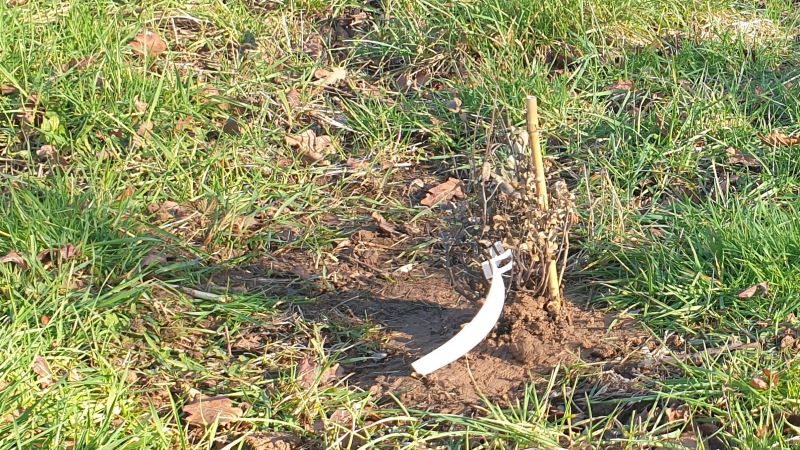
And, if the worst comes to the worst, we’ll just replace it before Alan comes to visit again. He lives in Northern Ireland and the lockdown rules means we won’t be seeing him any time soon. So, he’ll never know if we do have to replace it! Either way there’s going to be a sod-off big Eucalyptus tree in that corner of our native, deciduous forest!
Thanks, Alan!
We did plant another few leftover trees at the same time and, with that, our forest was complete.
Well, for now…
For me, the forest won’t be totally complete until I’m able to plant my orchard. I intend to create the orchard around three sides of the open space at the bottom of the field. And there’s really no rush for that. I’d much rather wait until all of the nurseries are open again and get the best fruit trees I can. After all, it’ll be a while before the trees of our forest are poking out the top of their tubes, let alone matching the height of established fruit tree saplings.
Besides, I can’t plant the orchard aspect of our forest until next winter, at the earliest. So I shall fill the intervening time with some leisurely research about what fruit trees I can get away with.
Of course, I’m going to have to spend a lot of the next couple of summers weaving my mower in and around the 1300 trees and shrubs of our forest. Otherwise the grass will smoother everything and we’ll have to plant the whole forest again.
And I don’t want that!
And then it’s just a case of waiting the 5 to 10 years, before I can remove the tubes from the trees…
I’m already looking forward to that day. It’s going to be awesome!
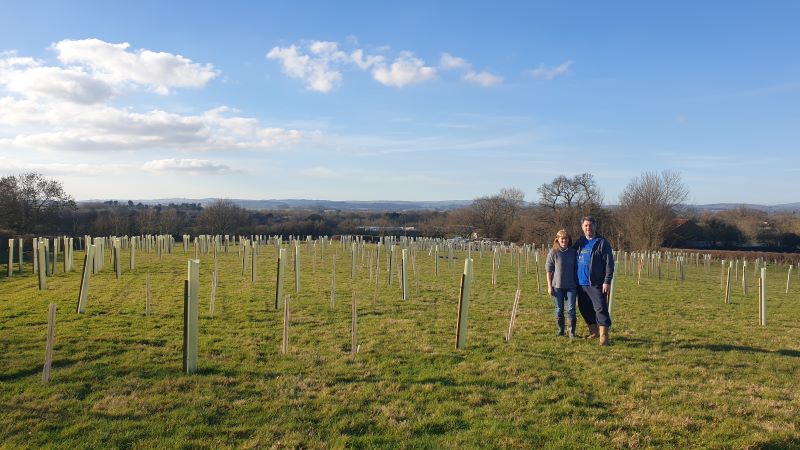
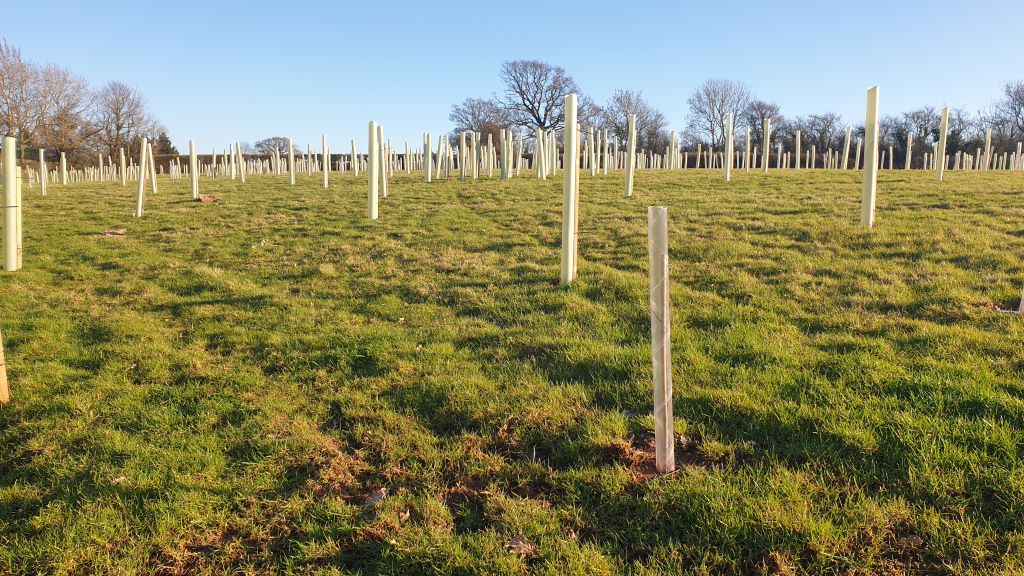
2 thoughts on “We Decided to Plant a Forest in our Field”
Paul, this is AMAZING!!! It’s been Brodie’s and my dream for years to buy a piece of land and plant a woodland and here you are smashing it! Loved reading your story so far and I’m looking forward to seeing how it grows! Xxx
Hi Emma,
Your time will come, there’s always going to be room for more forests. And when you do, we can compare notes on our respective woodlands…